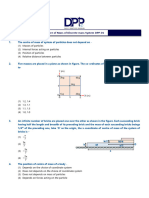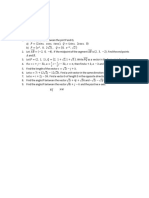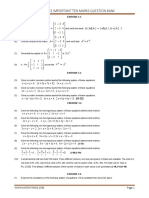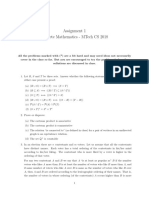CH 23 Problems
CH 23 Problems
Uploaded by
Damir HalilovićCopyright:
Available Formats
CH 23 Problems
CH 23 Problems
Uploaded by
Damir HalilovićOriginal Title
Copyright
Available Formats
Share this document
Did you find this document useful?
Is this content inappropriate?
Copyright:
Available Formats
CH 23 Problems
CH 23 Problems
Uploaded by
Damir HalilovićCopyright:
Available Formats
CS330: P ROBLEMS FOR M IDTERM A PRIL 22, 2011
2.18 We look at a comparison-based algorithm for a search in a sorted array as a binary tree in which a path from the root to a leaf represents a run of the algorithm. At every node a comparison takes place and, according to its result, a new comparison is performed. A leaf of the tree represents an output of the algorithm: the index of the element x that we are searching or it says that the element x does not appear in the array. All indices 1, . . . , n must appear as leaves or the algorithm will fail when x is at one of the missing indices, implying that the tree must have at least n leaves, and its depth must be (log n), which means that in the worst case it must perform at least (log n) comparisons.
2.30 (a) In order to nd for which , 2 , . . . , 6 are distinct modulo 7, we start by checking these powers for = 2, 3, . . . (Note that = 1 is trivial so we skip it) For = 2: = 2 2 (mod 7) 2 = 22 = 4 4 (mod 7) 3 = 23 = 8 1 (mod 7) 4 = 24 = 16 2 (mod 7) Since 4 = 2 (mod 7), 2 does not satisfy our conditions. For = 3: = 3 3 (mod 7) 2 = 32 = 9 2 (mod 7) 3 = 33 = 27 6 (mod 7) 4 = 34 = 81 4 (mod 7) 5 = 35 = 243 5 (mod 7) 6 = 36 = 729 1 (mod 7) It is easy to see that + 2 + 3 + 4 + 5 + 6 = 3 + 2 + 6 + 4 + 5 + 1 = 21 = 0 (mod 7) (b) The matrix M6 () becomes
1 1 1 M6 (3) = 1 1 1
1 3 2 6 4 5
1 2 4 1 2 4
1 6 1 6 1 6
1 4 2 1 4 2
1 5 4 6 2 3
April 22, 2011 and then 0 0 1 1 1 1 1 1 1 F T = M6 (3) = 1 1 1 5 5 1 2 2 1 (c) The inverse of M6 () is 1 3 2 6 4 5 1 2 4 1 2 4 1 6 1 6 1 6 1 4 2 1 4 2 1 0 3 1 6 5 4 1 4 = 6 1 2 2 5 3 3 2 3
1 1 1 1 M6 (3) = 6 1 1 1
1 5 4 6 2 3
1 4 2 1 4 2
1 6 1 6 1 6
1 2 4 1 2 4
1 3 2 6 4 5
1 Note that the entries in M6 (3) are obtained by taking the multiplicative inverse of the coresponding entry in M6 (3) in modular arithmetic: e.g. 53 = 15 = 1 (mod 7), which means that 3 is at (2,6) and (6,2) positions 1 in M6 (3) (5 is at these positions in M6 (3)). 1 1 6 in front of ( ) is (this is from our lectures) 6 n
(d) 1 + x + x2 = (1, 1, 1, 0, 0, 0) and 1 + 2x + x3 = (1, 2, 0, 1, 0, 0) = (6, 2, 0, 1, 0, 0). Again all here is done (mod 7), so -1 becomes 6 since the cycles for (mod 7) are . . . , (7, 6, 5, 4, 3, 2, 1), (0, 1, 2, 3, 4, 5, 6), (7, 8, 9, 10, 11, 12, 13), . . . from where one can see that for example -1=6=13=-8. Now 1 1 1 1 1 1 1 = M6 (3) 1 = 1 FT 0 1 0 0 0 1 0 0 1 and 1 6 6 2 1 2 0 = M6 (3) 0 = 1 FT 1 1 1 0 1 0 0 1 0 1 3 2 6 4 5 1 2 4 1 2 4 1 6 1 6 1 6 1 4 2 1 4 2 2 6 1 5 2 4 4 0 4 = 6 1 3 2 0 1 0 1 3 1 3 2 6 4 5 1 2 4 1 2 4 1 6 1 6 1 6 1 4 2 1 4 2 1 1 3 5 1 6 4 1 0 = 6 0 1 2 0 0 3 0 3
Multiply the obtained FTs componentwise as follows: 1 6 3 2 6 1 2 6 4 3 1 0 0 4 0 FT FT = = 0 1 1 3 3 0 0 0 1 0 0 0 3 1 3 and take the FT inverse of the last vector: 2
April 22, 2011 6 1 3 1 0 1 = 6 1 M6 (3) 1 3 0 1 3 1 1 6 1 6 3 6 1 3 2 0 = 6 6 = 1 4 3 6 3 6 1 4 0 5 3 6 1
1 5 4 6 2 3
1 4 2 1 4 2
1 6 1 6 1 6
1 2 4 1 2 4
which implies that (1 + x + x2 )(1 + 2x + x3 ) = 6 + x + x2 + 3x3 + x4 + x5 = 1 + x + x2 + 3x3 + x4 + x5 (use 1 = 6 (mod 7))
3.8. (a) Let S0 = 10, S1 = 7, S2 = 4 be the sizes of the corresponding containers, and let ai be the actual contents of the ith container. Let G = (V,E) be a directed graph, in which the nodes are triples of numbers (a0 , a1 , a2 ). It must hold 0 ai Si fori = 0, 1, 2 and at any given node a0 + a1 + a2 = 11 An edge between two nodes (a0 , a1 , a2 ) and (b0 , b1 , b2 ) exists if the following 2 conditions are satised: the two nodes differ in exactly two coordinates, and the third one is the same in both. if i, j are the coordinates they differ in, then either ai = 0 or aj = 0 or ai = Si or aj = Sj . The question is whether there exists a path between the nodes (0, 7, 4) and (#, 2, #) or (#, #, 2) where # stands for any allowed value of the corresponding coordinate. (b) Use DFS on the graph described in (a), starting from node (0, 7, 4) with an additional line of code that halts and answers yes if one of the desired nodes is reached and no if the connected component of the starting node is exhausted an no desired vertex is reached. (c) (0, 7, 4) (4, 7, 0) (10, 1, 0) (6, 1, 4) (6, 5, 0) (2, 5, 4) (2, 7, 2)
3.24 First linearize the DAG, and note that since in a linearized DAG edges can go only in increasing direction we can label its nodes by their position in the linearized order. To check if there is a directed path that touches every vertex exactly once it is enough to check if the DAG has an edge (i,i+1) for every pair of consecutive nodes i and i+1 (i and i+1 being their label (position) in the linearized order.). Linerization of DAGs takes linear time (see page 101 in DPV), and checking the edges for the pairs of consecutive nodes also takes linear time, which implies that the total running time is also linear.
You might also like
- Solutions Classical Dynamics of Particles and Systems 5edDocument496 pagesSolutions Classical Dynamics of Particles and Systems 5edRicardo Vega100% (8)
- Nicholson Solution For Linear Algebra 7th Edition.Document194 pagesNicholson Solution For Linear Algebra 7th Edition.Peter Li60% (5)
- MAT1503 Exam SolutionsDocument93 pagesMAT1503 Exam Solutionsd_systemsuganda100% (1)
- EECS 233 Final Exam Cheat Sheet PDFDocument2 pagesEECS 233 Final Exam Cheat Sheet PDFkmlkmlas100% (1)
- Theory GraphDocument23 pagesTheory GraphArthur CarabioNo ratings yet
- Guía 6Document13 pagesGuía 6Amalia GomezNo ratings yet
- Quiz3 SolutionDocument3 pagesQuiz3 Solution張育安No ratings yet
- Higher Order DeterminantsDocument28 pagesHigher Order DeterminantsKanda Agung KusumaNo ratings yet
- 6.1 Distance Between Two Points: Form 4 Additional Mathematics Chapter 6 Coordinate GeometryDocument19 pages6.1 Distance Between Two Points: Form 4 Additional Mathematics Chapter 6 Coordinate GeometryKenji Hedeki DexterNo ratings yet
- Chapter 2 Scan Conversion Algorithm - 241121 - 135049Document22 pagesChapter 2 Scan Conversion Algorithm - 241121 - 135049Bishal ShahNo ratings yet
- Sheet 3Document3 pagesSheet 3Hassan MolhamNo ratings yet
- Be Computer-Engineering Semester-3 2019 May Discrete-Structures-CbcgsDocument22 pagesBe Computer-Engineering Semester-3 2019 May Discrete-Structures-CbcgsSrinivas LakshmanNo ratings yet
- Modular NumberDocument70 pagesModular NumberPeiEnOngNo ratings yet
- MathsDocument6 pagesMathsAnujGoyalNo ratings yet
- An 8 and 12 Bit Block AES CipherDocument33 pagesAn 8 and 12 Bit Block AES Ciphershivanshu.siyanwalNo ratings yet
- 9 Class FaceDocument8 pages9 Class FaceViswaNo ratings yet
- CS426 SolutionForHomework1Document6 pagesCS426 SolutionForHomework1vijuNo ratings yet
- Analytical Geometry: y y M X XDocument10 pagesAnalytical Geometry: y y M X XKomanduri Murali SrinivasNo ratings yet
- Tutorial 6 Matrix Algebra For Non-Homogeneous Linear Algebraic SystemDocument4 pagesTutorial 6 Matrix Algebra For Non-Homogeneous Linear Algebraic Systemmarshaldavid205No ratings yet
- Lecture 5Document5 pagesLecture 5vaibhav shivhareNo ratings yet
- endsem_ML_makeup_AK-_1_Document7 pagesendsem_ML_makeup_AK-_1_Ambati BramarambikaNo ratings yet
- Vektor Untuk Kalkulus 2Document77 pagesVektor Untuk Kalkulus 2svitri94No ratings yet
- Quiz 1 (Chapter 14) - SolutionsDocument12 pagesQuiz 1 (Chapter 14) - Solutionsxperia30No ratings yet
- UACE MATHEMATICS PAPER 1 2014 Marking GuideDocument14 pagesUACE MATHEMATICS PAPER 1 2014 Marking GuideSamuel Harv100% (2)
- MAT1341 Midterm SolutionDocument3 pagesMAT1341 Midterm SolutionKerensa DalanNo ratings yet
- ClassXII Topper Sample Paper 50Document26 pagesClassXII Topper Sample Paper 50Mohit SharmaNo ratings yet
- HW 4Document9 pagesHW 4pt422No ratings yet
- Some Solutions To The Problems On Practice Quiz 3Document3 pagesSome Solutions To The Problems On Practice Quiz 3Innefebrianty Meiga HabelNo ratings yet
- Jee Main Paper (Maths) (13-4-2023) MorningDocument18 pagesJee Main Paper (Maths) (13-4-2023) Morningxanderdragon777No ratings yet
- PEME200001 Mathematical Techniques 2Document10 pagesPEME200001 Mathematical Techniques 2Andrew AndersonNo ratings yet
- 2024-2025-Class XI-Mathematics-Chapter 10-AWDocument4 pages2024-2025-Class XI-Mathematics-Chapter 10-AWthanushrianilkumar2008No ratings yet
- 53 - 36765 - ME593 - 2014 - 1 - 1 - 1 - Input, Output ModulesDocument3 pages53 - 36765 - ME593 - 2014 - 1 - 1 - 1 - Input, Output ModulesRanu GamesNo ratings yet
- AE 321 - Solution of Homework #2Document7 pagesAE 321 - Solution of Homework #2Arthur DingNo ratings yet
- Homework 10 (Level 3)Document8 pagesHomework 10 (Level 3)rihitgandhiNo ratings yet
- Teknik Menjawab Matematik Spm2009Document25 pagesTeknik Menjawab Matematik Spm2009adeksam72No ratings yet
- Sheet 03Document3 pagesSheet 03ejadamousaNo ratings yet
- Daa AllDocument24 pagesDaa AllPoison RemarkNo ratings yet
- EST-2-Math-Level-2 Sample TestDocument14 pagesEST-2-Math-Level-2 Sample Testepsf.jacobbolesNo ratings yet
- Center of Mass and CollisionDocument51 pagesCenter of Mass and CollisionNaksh bhatiNo ratings yet
- Dif Cal-1Document15 pagesDif Cal-1tukmol republicNo ratings yet
- CST294 DDocument4 pagesCST294 Daswathy.24achusNo ratings yet
- 12 - HPW 13 Ism 06 PDFDocument53 pages12 - HPW 13 Ism 06 PDF蔥蔥No ratings yet
- EOI2022 Math2Document3 pagesEOI2022 Math2Mohamed El-SherifNo ratings yet
- 46 THE POINT DDDDDDDDDDDDDDDDocument22 pages46 THE POINT DDDDDDDDDDDDDDDVishal VjNo ratings yet
- UntitledDocument5 pagesUntitledXiangming ShenNo ratings yet
- ODD06Document39 pagesODD06Maximiliano E. Asis LopezNo ratings yet
- Pahang MathsT P1 2015 QA PDFDocument11 pagesPahang MathsT P1 2015 QA PDFZakwan HassanNo ratings yet
- C4 Bronze 4Document18 pagesC4 Bronze 4Betty MakharinskyNo ratings yet
- Manoj Chauhan Sir: Mathematics byDocument30 pagesManoj Chauhan Sir: Mathematics byRaval sagarNo ratings yet
- Find the distance between the pint P and QDocument3 pagesFind the distance between the pint P and Qsyum amareNo ratings yet
- Question Bank For Mid Sem All Dept Sem 1 202425Document3 pagesQuestion Bank For Mid Sem All Dept Sem 1 202425Dwij MistryNo ratings yet
- Problem Set 1Document4 pagesProblem Set 1Anushka VijayNo ratings yet
- 2 Mathematics Important Ten Marks Question BankDocument16 pages2 Mathematics Important Ten Marks Question BankSri RamNo ratings yet
- 1 MinHash-1Document4 pages1 MinHash-1Houssam FoukiNo ratings yet
- Sma1102 Tutorial Worsheet (All Sections)Document2 pagesSma1102 Tutorial Worsheet (All Sections)MILDRED MHAKANo ratings yet
- Maths (Question Paper & Solution)Document7 pagesMaths (Question Paper & Solution)Om HotkarNo ratings yet
- All DPP - 240920 - 142404Document51 pagesAll DPP - 240920 - 142404srigurujuniorcollege14No ratings yet
- 14-Elliptic Curve Cryptography (ECC) - 27!02!2024Document31 pages14-Elliptic Curve Cryptography (ECC) - 27!02!2024YashNo ratings yet
- Analytic Geometry: Graphic Solutions Using Matlab LanguageFrom EverandAnalytic Geometry: Graphic Solutions Using Matlab LanguageNo ratings yet
- Transformation of Axes (Geometry) Mathematics Question BankFrom EverandTransformation of Axes (Geometry) Mathematics Question BankRating: 3 out of 5 stars3/5 (1)
- Trigonometric Ratios to Transformations (Trigonometry) Mathematics E-Book For Public ExamsFrom EverandTrigonometric Ratios to Transformations (Trigonometry) Mathematics E-Book For Public ExamsRating: 5 out of 5 stars5/5 (1)
- Graph Theory-Unit1Document38 pagesGraph Theory-Unit1Kranthi KumarNo ratings yet
- D16 R Discrete Mathematics and CombinatoryDocument20 pagesD16 R Discrete Mathematics and CombinatoryEfrem GirmaNo ratings yet
- Graph Theory PDFDocument7 pagesGraph Theory PDFAayush BorkarNo ratings yet
- Topic 11 Path and CycleDocument11 pagesTopic 11 Path and Cycleعبدالرحيم اودينNo ratings yet
- COMPSCI120-2021-S1-exam SolutionsDocument7 pagesCOMPSCI120-2021-S1-exam SolutionsHenry XuNo ratings yet
- Design and Analysis of Algorithms Week 11 Lecture 19: Dr. Husnain Mansoor AliDocument29 pagesDesign and Analysis of Algorithms Week 11 Lecture 19: Dr. Husnain Mansoor AliMuhammad AmmarNo ratings yet
- Heuristics and Local SearchDocument31 pagesHeuristics and Local Searchreno303No ratings yet
- DAA JournalDocument71 pagesDAA JournalSHRUTI CHAVANNo ratings yet
- Daa Week 8Document3 pagesDaa Week 8NikileshNo ratings yet
- Euler Circuit/Path ExamplesDocument4 pagesEuler Circuit/Path ExamplesOmar MorenoNo ratings yet
- Graph Theory Assignment 2Document8 pagesGraph Theory Assignment 23017 Antara Mudi Cse AiNo ratings yet
- Syncronised Oscillatory Networks: Applications To Graph ColouringDocument1 pageSyncronised Oscillatory Networks: Applications To Graph ColouringKrishna SubramaniNo ratings yet
- Assignment 1Document2 pagesAssignment 1Arnab RayNo ratings yet
- 02 FermetureTransitive-ENDocument2 pages02 FermetureTransitive-ENHong KimmengNo ratings yet
- DSA Unit-5Document230 pagesDSA Unit-5PAREEKSHITH PARUCHURI (RA2111028010039)No ratings yet
- Chapter 6 - Mining Social Network Graphs PDFDocument74 pagesChapter 6 - Mining Social Network Graphs PDFMamNo ratings yet
- Matchings and Factors: Meenakshi D'SouzaDocument13 pagesMatchings and Factors: Meenakshi D'SouzaNaman DosiNo ratings yet
- DAA Question Bank-Unit 3Document30 pagesDAA Question Bank-Unit 3pubg64645No ratings yet
- Data StructureDocument6 pagesData Structuremohit1485No ratings yet
- 5-Straight Line GraphsDocument15 pages5-Straight Line GraphsSameh SalahNo ratings yet
- DM - Graph Connectivity: NGUYEN Hoang ThachDocument16 pagesDM - Graph Connectivity: NGUYEN Hoang ThachKatto - Darling in the PianoNo ratings yet
- Euler Graph: K. Karthika SAS - Mathematics VIT, VelloreDocument21 pagesEuler Graph: K. Karthika SAS - Mathematics VIT, Vellorevenkat sathwik kethepalliNo ratings yet
- Lecture Notes in Computer Science 4976: Editorial BoardDocument714 pagesLecture Notes in Computer Science 4976: Editorial BoardEliasHigueraAcostaNo ratings yet
- Problem Set in Pre-CalDocument10 pagesProblem Set in Pre-CalRizza FalconNo ratings yet
- Relations and Functions - Activity ModuleDocument4 pagesRelations and Functions - Activity ModuleNoreen RavaneraNo ratings yet
- Exercise (Mod6) 2.1 - KimuraDocument4 pagesExercise (Mod6) 2.1 - Kimuraellie sereneNo ratings yet
- Connected Biconnected ComponentsDocument6 pagesConnected Biconnected ComponentssNo ratings yet
























































































